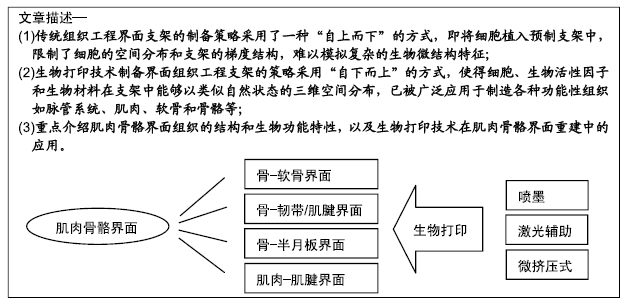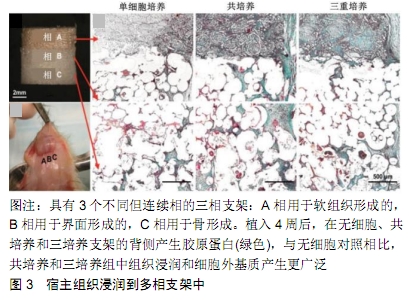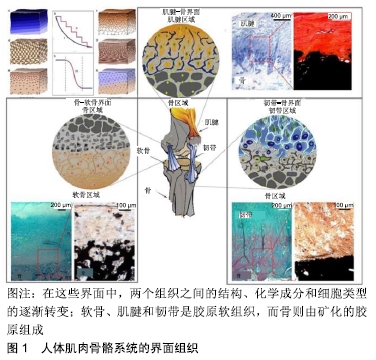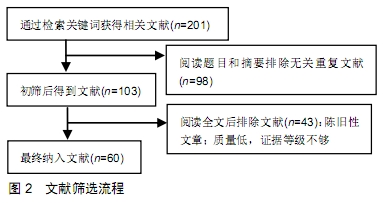[1] CROSS LM, THAKUR A, JALILI NA, et al. Nanoengineered biomaterials for repair and regeneration of orthopedic tissue interfaces. Acta Biomater.2016;42:2-17.
[2] REY-RICO A, CUCCHIARINI M. Smart and Controllable rAAV Gene Delivery Carriers in Progenitor Cells for Human Musculoskeletal Regenerative Medicine with a Focus on the Articular Cartilage. Curr Gene Ther.2017;17(2):127-138.
[3] SAHOO S, TEH T, HE P, et al. Interface tissue engineering: next phase in musculoskeletal tissue repair.Ann Acad Med Singapore.2011;40(5):245-251.
[4] MERCERON TK, BURT M, SEOL YJ, et al. A 3D bioprinted complex structure for engineering the muscle-tendon unit. Biofabrication.2015;7(3):035003.
[5] ANDARAWIS-PURI N, FLATOW EL, SOSLOWSKY LJ. Tendon basic science: Development, repair, regeneration, and healing. J Orthop Res.2015;33(6):780-784.
[6] PETRIGLIANO FA, MCALLISTER DR, WU BM. Tissue engineering for anterior cruciate ligament reconstruction: a review of current strategies.Arthroscopy.2006;22(4):441-451.
[7] SILVA MJ, THOMOPOULOS S, KUSANO N, et al. Early healing of flexor tendon insertion site injuries: Tunnel repair is mechanically and histologically inferior to surface repair in a canine model. J Orthop Res.2006;24(5):990-1000.
[8] CHEN MH, WANG LL, CHUNG JJ, et al. Methods To Assess Shear-Thinning Hydrogels for Application As Injectable Biomaterials. Acs Biomater Sci Eng.2017;3(12):3146-6310.
[9] BOUSHELL MK, HUNG CT, HUNZIKER EB,et al. Current strategies for integrative cartilage repair. Connect Tissue Res. 2017; 58(5):393-406.
[10] MAKRIS EA, GOMOLL AH, MALIZOS KN, et al. Repair and tissue engineering techniques for articular cartilage.Nat Rev Rheumatol.2015;11:21-34.
[11] NUKAVARAPU SP, DORCEMUS DL. Osteochondral tissue engineering: current strategies and challenges.Biotechnol adv. 2013;31(5):706-721.
[12] SEIDI A, RAMALINGAM M, ELLOUMI-HANNACHI I, et al. Gradient biomaterials for soft-to-hard interface tissue engineering.Acta Biomater.2011;7:1441-1451.
[13] MIR TA, NAKAMURA M. Three-Dimensional Bioprinting: Toward the Era of Manufacturing Human Organs as Spare Parts for Healthcare and Medicine.Tissue Eng Part B Rev. 2017;23(3):245-256.
[14] CRISCENTI G, LONGONI A, DI LUCA A, et al. Triphasic scaffolds for the regeneration of the bone-ligament interface. Biofabrication. 2016;8(1):015009.
[15] LIU W, LIPNER J, XIE J, et al. Nanofiber scaffolds with gradients in mineral content for spatial control of osteogenesis. ACS Appl Mater Interfaces. 2014;6(4):2842-2849.
[16] NGUYEN QT, JACOBSEN TD, CHAHINE NO. Effects of Inflammation on Multiscale Biomechanical Properties of Cartilaginous Cells and Tissues.Acs Biomater Sci Eng. 2017; 3(11):2644-2656.
[17] PIMENTEL CR, KO SK, CAVIGLIA C, et al. Three-dimensional fabrication of thick and densely populated soft constructs with complex and actively perfused channel network.Acta Biomater.2018;65:174-184.
[18] SUNTORNNOND R, TAN EYS, AN J, et al. A highly printable and biocompatible hydrogel composite for direct printing of soft and perfusable vasculature-like structures.Sci Rep. 2017; 7(1):16902.
[19] MEKHILERI NV, LIM KS, BROWN GCJ, et al. Automated 3D bioassembly of micro-tissues for biofabrication of hybrid tissue engineered constructs.Biofabrication. 2018;10(2): 024103.
[20] KOO Y, KIM G. New strategy for enhancing in situ cell viability of cell-printing process via piezoelectric transducer-assisted three-dimensional printing. Biofabrication.2016;8(2):025010.
[21] LIU X, YUK H, LIN S, et al. 3D Printing of Living Responsive Materials and Devices.Adv Mater.2018;30(4):201704821.
[22] NAGARAJAN N,DUPRET-BORIES A,KARABULUT E,et al. Enabling personalized implant and controllable biosystem development through 3D printing.Biotechnol Adv. 2018;36(2): 521-533.
[23] ZHANG YS, YUE K, ALEMAN J, et al. 3D Bioprinting for Tissue and Organ Fabrication.Ann Biomed Eng.2017;45(1):148-163.
[24] XIONGFA J, HAO Z, LIMING Z, et al. Recent advances in 3D bioprinting for the regeneration of functional cartilage.Regen Med.2018;13(1):73-87.
[25] GAO G, HUANG Y, SCHILLING AF, et al. Organ Bioprinting: Are We There Yet? Adv Healthc Mater. 2018;7(1):201701018.
[26] RAVNIC DJ, LEBERFINGER AN, KODURU SV, et al. Transplantation of Bioprinted Tissues and Organs: Technical and Clinical Challenges and Future Perspectives.Ann Surg. 2017;266(1):48-58.
[27] YANG Y, SONG X, LI X, et al. Recent Progress in Biomimetic Additive Manufacturing Technology: From Materials to Functional Structures.Adv Mater.2018;19:e1706539.
[28] LEVATO R, WEBB WR, OTTO IA, et al. The bio in the ink: cartilage regeneration with bioprintable hydrogels and articular cartilage-derived progenitor cells.Acta Biomater. 2017;61:41-53.
[29] MOUSER VHM, LEVATO R, MENSINGA A, et al. Bio-ink development for three-dimensional bioprinting of hetero-cellular cartilage constructs.Connect Tissue Res. 2018:1-15.
[30] YANG J, ZHANG YS, YUE K, et al. Cell-laden hydrogels for osteochondral and cartilage tissue engineering.Acta Biomater. 2017;57:1-25.
[31] HUANG Y, ZHANG XF, GAO G, et al. 3D bioprinting and the current applications in tissue engineering.Biotechnol J. 2017; 12(8).doi:10.1002/biot.201600734.
[32] BRACAGLIA LG, SMITH BT, WATSON E, et al.3D printing for the design and fabrication of polymer-based gradient scaffolds. Acta Biomater.2017;56:3-13.
[33] MORA-BOZA A, LOPEZ-DONAIRE ML. Preparation of Polymeric and Composite Scaffolds by 3D Bioprinting.Adv Exp Med Biol.2018;1058:221-245.
[34] PATI F, CHO DW. Bioprinting of 3D Tissue Models Using Decellularized Extracellular Matrix Bioink.Methods Mol Biol. 2017;1612:381-390.
[35] DEMIRTAS TT, IRMAK G, GUMUSDERELIOGLU M. A bioprintable form of chitosan hydrogel for bone tissue engineering.Biofabrication.2017;9(3):035003.
[36] MARTINEZ PR, GOYANES A, BASIT AW, et al. Fabrication of drug-loaded hydrogels with stereolithographic 3D printing.Int J Pharm.2017;532(1):313-317.
[37] YOON S, PARK JA, LEE HR, et al. Inkjet-Spray Hybrid Printing for 3D Freeform Fabrication of Multilayered Hydrogel Structures.Adv Healthc Mater.2018;7(14):e1800050.
[38] MARQUES CF, DIOGO GS, PINA S, et al. Collagen-based bioinks for hard tissue engineering applications: a comprehensive review.J Mater Sci Mater Med.2019;30(3):32.
[39] DISCHER DE, MOONEY DJ, ZANDSTRA PW. Growth factors, matrices, and forces combine and control stem cells. Science. 2009;324(5935):1673-1677.
[40] VINING KH, MOONEY DJ. Mechanical forces direct stem cell behaviour in development and regeneration.Nat Rev Mol Cell Biol.2017;18(12):728-742.
[41] DI LUCA A, VAN BLITTERSWIJK C, MORONI L. The osteochondral interface as a gradient tissue: from development to the fabrication of gradient scaffolds for regenerative medicine.Birth Defects Res C Embryo Today. 2015;105(1):34-52.
[42] OLIVEIRA I, VIEIRA S, OLIVEIRA JM, et al. Nanoparticles-Based Systems for Osteochondral Tissue Engineering.Adv Exp Med Biol.2018;1059:209-217.
[43] PEREIRA DR, REIS RL, OLIVEIRA JM. Layered Scaffolds for Osteochondral Tissue Engineering. Adv Exp Med Biol. 2018; 1058:193-218.
[44] ZHANG Y, WANG F, TAN H, et al. Analysis of the mineral composition of the human calcified cartilage zone.Int J Med Sci.2012;9(5):353-360.
[45] LONGLEY R, FERREIRA AM, GENTILE P. Recent Approaches to the Manufacturing of Biomimetic Multi-Phasic Scaffolds for Osteochondral Regeneration.Int J Mol Sci. 2018; 19(6).pii: E1755.doi:10.3390/ijms19061755.
[46] PARK JY, CHOI JC, SHIM JH, et al. A comparative study on collagen type I and hyaluronic acid dependent cell behavior for osteochondral tissue bioprinting. Biofabrication. 2014;6(3): 035004.
[47] LEVATO R, VISSER J, PLANELL JA, et al. Biofabrication of tissue constructs by 3D bioprinting of cell-laden microcarriers. Biofabrication.2014;6(3):035020.
[48] DI BELLA C, DUCHI S, O'CONNELL CD, et al. In situ handheld three-dimensional bioprinting for cartilage regeneration.J Tissue Eng Regen Med.2018;12(3):611-621.
[49] ONOFRILLO C, DUCHI S, O'CONNELL CD, et al. Biofabrication of human articular cartilage: a path towards the development of a clinical treatment.Biofabrication.2018;10(4): 045006.
[50] SPALAZZI JP, DAGHER E, DOTY SB, et al. In vivo evaluation of a multiphased scaffold designed for orthopaedic interface tissue engineering and soft tissue-to-bone integration. J Biomed Mater Res A.2008;86(1):1-12.
[51] NOWLIN J, BISMI MA, DELPECH B, et al. Engineering the hard-soft tissue interface with random-to-aligned nanofiber scaffolds.Nanobiomedicine.2018;5:1849543518803538.
[52] HARRIS E, LIU Y, CUNNIFFE G, et al. Biofabrication of soft tissue templates for engineering the bone-ligament interface. Biotechnol Bioeng. 2017;114(10):2400-2411.
[53] YANG PJ, TEMENOFF JS. Engineering orthopedic tissue interfaces.Tissue Eng Part B Rev.2009;15:127-141.
[54] SPALAZZI JP, DOTY SB, MOFFAT KL, et al. Development of controlled matrix heterogeneity on a triphasic scaffold for orthopedic interface tissue engineering.Tissue Eng. 2006; 12(12):3497-3508.
[55] KIM HM, GALATZ LM, DAS R, et al. Musculoskeletal deformities secondary to neurotomy of the superior trunk of the brachial plexus in neonatal mice.J Orthop Res. 2010; 28(10):1391-1398.
[56] WARREN PB, HUEBNER P, SPANG JT, et al. Engineering 3D-Bioplotted scaffolds to induce aligned extracellular matrix deposition for musculoskeletal soft tissue replacement. Connect Tissue Res. 2017;58(3-4):342-354.
[57] ROMANAZZO S, VEDICHERLA S, MORAN C, et al. Meniscus ECM-functionalised hydrogels containing infrapatellar fat pad-derived stem cells for bioprinting of regionally defined meniscal tissue. J Tissue Eng Regen Med. 2018;12(3):e1826-e1835.
[58] ONG CS, YESANTHARAO P, HUANG CY, et al. 3D bioprinting using stem cells.Pediatr Res. 2018;83:223-231.
[59] MARKSTEDT K, MANTAS A, TOURNIER I, et al. 3D Bioprinting Human Chondrocytes with Nanocellulose-Alginate Bioink for Cartilage Tissue Engineering Applications. Biomacromolecules.2015;16(5):1489-1496.
[60] STEINERT AF, PALMER GD, CAPITO R, et al. Genetically enhanced engineering of meniscus tissue using ex vivo deliVery of transforming growth factor-beta 1 complementary deoxylibonucleic acid. Tissue Eng.2007;13(9):2227-2237.
|





